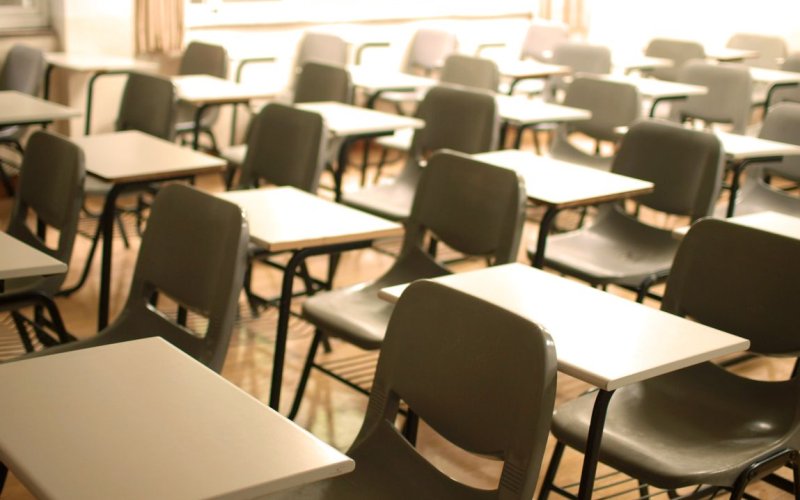School of Public Health Study Finds Students, Educators Often Experience Extreme Heat Conditions

By Erin Frick
ALBANY, N.Y. (Jan. 26, 2022) — Students frequently experience uncomfortable temperature and humidity at school, which could be detrimental to their health and education, according to a recent study by University at Albany School of Public Health researchers.
The study, which focused on the Capital Region, tracked primary school and university students’ exposure to indoor temperature and relative humidity levels using personal air monitors across seasons.
Findings were recently published in Hygiene and Environmental Health Advances.
“In the northeastern U.S., cold winters mean we have to turn up the heat — making indoor conditions in many places overly hot and dry,” said Shao Lin, senior co-author on the study and professor of Environmental Health Sciences at UAlbany’s School of Public Health. “For students, hot classrooms can make it difficult to concentrate while low humidity harms airways, making it easier for respiratory viruses to take hold. Dry air can also cause eye irritation and disrupt sleep.
“When we look to the warmer months, few schools in the Capital Region are equipped to adequately cool classrooms, especially as climate change is causing unusually hot days in the fall and spring. Our findings highlight the need to improve thermal conditions in classrooms to facilitate student success.”
Monitoring Personal Air Conditions
The research team used AirBeam personal air monitors to track the temperature and relative humidity levels that students and teachers in Capital Region public schools experience throughout the day — including time spent at home, in transit and at school. The study included data from 11 classrooms from six primary schools (48 participants), plus two classrooms at UAlbany (29 participants).
The AirBeam monitors measure temperature, relative humidity and particulate matter concentrations at one-minute intervals. Data from each device is streamed to a smartphone via Bluetooth. Each study participant undertook two monitoring sessions: one in the spring and another in either the fall or winter. In each monitoring session, participants wore a personal air monitor continuously for 48 hours.
The team compared conditions recorded by the AirBeam monitors to recommended indoor temperature and relative humidity levels. The American Society of Heating, Refrigeration and Air-Conditioning Engineers (ASHRAE) recommends an indoor air temperature range of 75-80.5 degrees Fahrenheit in the summer and 68.5-75 degrees Fahrenheit in the winter. According to the U.S. EPA, indoor relative humidity should be kept between 30 and 60 percent.
Often Too Hot; Rarely “Just Right”
The team found that for primary school participants, the hottest point of the day detected via AirBeam consistently occurred when participants were at school, with peaks happening around 3 p.m. in the spring, 1:45 p.m. in the fall and 11:45 a.m. in the winter. AirBeam measurements revealed that classroom temperatures consistently exceeded ASHRAE standards, with maximum temperatures reaching 93 degrees Fahrenheit in the spring and 91 degrees Fahrenheit in the fall and winter.
Across all seasons in primary school classrooms, average relative humidity hovered around the recommended minimum of 30 percent. However, across seasons, relative humidity varied widely, ranging from 11-53 percent in the winter, 11-70 percent in the spring and 15-75 percent in the fall.
“Humidity needs to be kept within a particular range to protect health,” said Lin. “Air that is drier than recommended can damage airways, help pathogens spread and cause irritation. Air that is too moist can lead to mold growth, which can cause respiratory problems. While the average humidity level experienced by primary school participants averaged around recommended levels, these wide ranges mean that they were often exposed to overly dry and moist conditions.”
Temperature trends experienced by university participants were similar to primary school participants, with peak temperatures happening slightly later in the day across seasons. The overall temperature range was larger, but not by a significant margin. University participants consistently experienced lower relative humidity than their primary school counterparts.
Prioritizing Classroom Comfort
“Comfortable classroom environments help students learn and stay healthy,” said study co-author Ian Ryan, who led the research while pursuing a PhD in Environmental Health Sciences at UAlbany and is now a postdoctoral fellow at the National Institutes of Health. “Our findings indicate that students are often exposed to conditions that are hotter than recommended, with relative humidity levels beyond the recommended range. This makes them more susceptible to illness, while also posing challenges to concentration and students’ ability to focus.”
“While the sample size in this study is relatively small and confined to a limited geographic area, we believe that these problems are likely widespread in classrooms, especially in the northeastern U.S., where heatwaves in the spring and fall increasingly coincide with students being in school. Taking steps to install or upgrade air conditioning and ventilation systems in schools could help alleviate this issue. Affording teachers greater control over their classroom temperature and airflow could also help.”
“To ensure students have the best possible opportunity to succeed in school, it is critical that we take indoor climate into account,” said Lin. “Keeping classrooms cool, with appropriate humidity, can help improve focus and productivity, with benefits for students’ physical health.”




